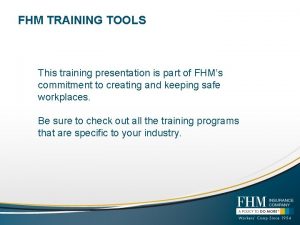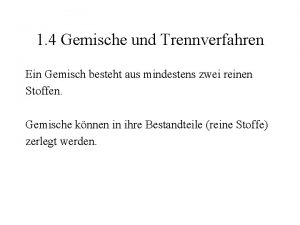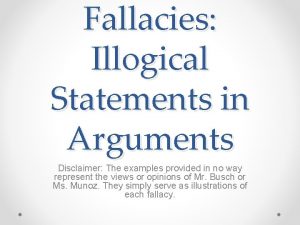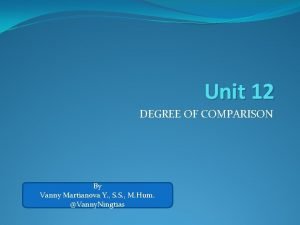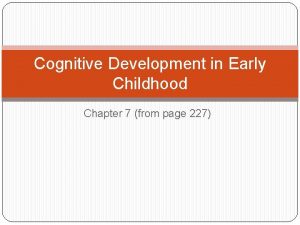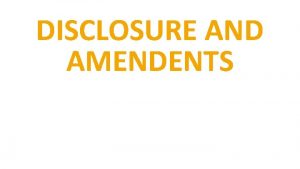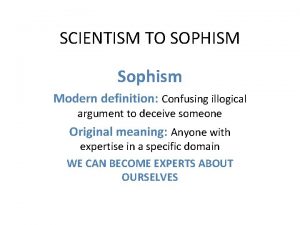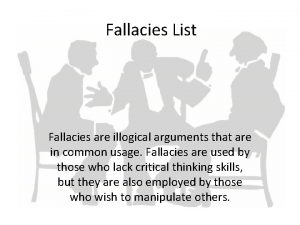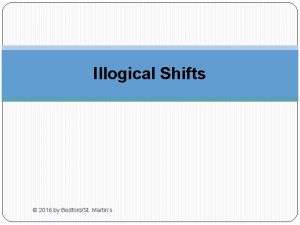COMMON ILLOGICAL DECISIONS Daniel Rauch MD FAAP FHM





















- Slides: 21

COMMON ILLOGICAL DECISIONS Daniel Rauch, MD, FAAP, FHM Associate Professor of Pediatrics Mount Sinai School of Medicine Associate Director of Pediatrics Elmhurst Hospital Center Congratulations to the San Francisco Giants 2010 World Series Champions

Case 1 4 yo boy with CC of fever, HA, lethargy, and vomiting (ie. He’s sick). HPI: well until yesterday when had tactile temp, dec PO, dec active, went to sleep early, woke up and then back to sleep and now difficult to arouse, previously well, no trauma PE sig for T 103° HR 170 RR 28 BP 85/56, ill appearing, lethargic, meningismus

Case 1 DD – Meningitis at top of list Plan – LP + other tests then lots of antibiotics But, someone suggests that he needs a head CT prior to LP in case of high ICP and possible herniation during LP so off he goes to radiology

CT – Really? Herniation risks Rennick G et al. Cerebral herniation during bacterial meningitis in children. BMJ 1993; 306(6883): 953 -5 The temporal relation between lumbar puncture and herniation strongly suggests that a lumbar puncture may cause herniation in some patients, and normal results on computed tomography do not mean that it is safe to do a lumbar puncture in a child with bacterial meningitis. Shetty AK et al. Fatal cerebral herniation after lumbar puncture in a patient with a normal computed tomography scan. Pediatrics 1999;

Maybe too sick for LP? When the OP is very high, just enough fluid (usually 2 to 4 m. L) should be removed to permit a careful examination The use of a small bore needle (21 - or 22 -gauge) is recommended whenever there is concern about increased ICP to minimize the CSF leak from the LP site. Joffe AR. Lumbar Puncture and Brain Herniation in Acute Bacterial Meningitis: A Review. J Int Care Med 2007; 22: 194207 The risk of not doing an LP when it is considered contraindicated because of concern of the risk of herniation is very small. Van Crevel H et al. Lumbar puncture and the risk of herniation: when should we first perform CT? J Neurol 2002; 249 : 129– 137 Of course CT should be preceded by obtaining blood cultures and starting antibiotic treatment without delay

What if LP not done before abx? Kanegaye JT et al. Lumbar Puncture in Pediatric Bacterial Meningitis: Defining the Time Interval for Recovery of Cerebrospinal Fluid Pathogens After Parenteral Antibiotic Pretreatment. Pediatrics 2001; 108; 1169 -1174 complete sterilization of meningococcus within 2 hours and the beginning of sterilization of pneumococcus by 4 hours into therapy

Case 2 4 yo boy with hx of RAD presents with 3 d URI sx, 2 d fever, 2 d cough, today with post-tussive emesis PE sig for RR 32, 1+ wheeze, 1+ retractions, good air movement, rhonchi at bases R>L, POX RA 93% CXR done because of fever and resp sx sig for atelectasis R base Still in mild resp distress after 3 albuterol/atrovent and PO steroids so given Ceftriaxone and admitted with dx of Asthmonia

Why CXR? Pneumonia is a clinical dx Hypoxia unusual in “mild” pneumonia Hypoxia results from V/Q mismatch – need a large amount of lung involvement CXR NOT helpful in differentiating bacterial vs viral CXR known to ‘lag’ behind clinical sx CXR of asthma can look like pneumonia CXR not recommended for routine assessment of asthma - NHLBI guidelines

Asthma vs Pneumonia Wheeze – TRUE musical sounds – suggestive of NOT classic bacterial etiology RAD, viral, or mycoplasma BTS Guidelines for the Management of Community Acquired Pneumonia in Childhood. Thorax 2002; 57(Suppl. 1)1— 24. Ruuskanen O, Mertsola J. Childhood communityacquired pneumonia. Semin Respir Infect 1999; 14: 163 – 72. The co-incidence of asthma and pneumococcal pneumonia is exceedingly small

Treatment – Cefakillall First line abx for CAP in children is high-dose Amoxicillin T. Hazir et al. Ambulatory short-course high-dose oral amoxicillin for treatment of severe pneumonia in children: a randomised equivalency trial, The Lancet 2008; 371: 49 -56 Cephalosporins, 2 nd then 3 rd generation commonly used from prior to Hib vaccine True pneumococcal resistance still rare Intermediate resistance common – a lab designation and not clinically relevant Steroids? ? ?

Case 3 2 yo boy presents with Diarrhea and vomiting for 2 days, decreased urine output. Parents tried ginger ale. During 2 -hour wait more vomiting. IV fluids ordered upon assessment; IV takes 3 attempts and vomits during attempts, Chem 7 drawn: BUN 15, Creat. 8, HCO 3 12 Admitted to hospital 5 hours post-arrival for dehydration, low bicarb, and failed PO Made NPO overnight and continued on IVF

Dehydration assessment WHO Hydration Assessment or Either way…poor reliability

Dehydration Scores Gorelick score Characteristic Score of 0 Score of 1 Gen appearance Normal Abnormal Cap refill <2 sec >2 sec Mucus membranes Moist Dry Tears Present Absent Gorelick MH et al. Validity and Reliability of Clinical Signs in the Diagnosis of Dehydration in Children Pediatrics 1997; 99: e 6 0=no dehydration 1=mild dehydration 2=mod dehydration 3 -4=severe dehydration

Dehydration Scores Clinical Dehydration Score Characterisit c Score of 0 Score of 1 Score of 2 Gen appearance Normal Thisty, restless, or lethargic Drowsy, limp, cold, sweaty, comatose Eyes Normal Slightly sunken Very sunken Mucus membranes Moist Sticky Dry Tears Decreased Absent Goldman RD et al. Validation of the Clinical Dehydration Scale for Children With Acute Gastroenteritis. Pediatrics 2008, 122; 545 -549 0=no dehydration 1 -4=mild dehydration 5 -8=mod/severe dehydration

Labs? AAP, CDC, and ACEP guidelines agree that routine laboratory testing does not contribute to the assessment of hydration in children with uncomplicated gastroenteritis AAP and CDC endorsed: King CK et al. MMWR Recomm Rep. 2003; 52: 1 -16 www. cdc. gov. mmwr/preview/mmwrhtml/rr 5216 al. htm ACEP. The Management of Children with Gastroenteritis and Dehydration in the Emergency Department. J Emerg Med 2010; 38: 686 -96 No single laboratory value has been found to be accurate in predicting the degree of dehydration and this is not routinely recommended.

ORT vs IVF Oral Rehydration Therapy First choice for mild-to-moderate dehydration Physiologic Improved parent satisfaction Simple, noninvasive, low cost Requires less time and fewer resources than IVRT Avoids need for catheter placement and potential complications associated with IVRT Can be administered in any setting NOT for severe dehydration Atherly-John YC et al. Arch Pediatr Adolesc Med. 2002; 156: 1240 - 1243 Spandorfer PR et al. Pediatrics. 2005; 115: 295 -301

NPO and IVF? NPO for AGE – why? ORT… Cincinnati AGE guidelines 2006 It is recommended that refeeding of the usual diet be started at the earliest opportunity after an adequate degree of rehydration is achieved – not BRAT, not dairy-free IVF Rehydration over 24 hrs (48 for hypernatremia) Vs evidence of iatrogenic hyponatremia Moritz ML, Ayas JC. Prevention of Hospital-Acquired Hyponatremia: A Case for Using Isotonic Saline. Pediarics 2003; 111: 227 -30

Case 4 2 yo girl with CC of increasing neck mass despite oral Augmentin. Sx started 5 d ago with URI sx and sore throat, 3 d PTA pt noted with fever and L neck swelling, seen by PMD where rapid strep was neg, no tx given, following day neck mass increased so started on PO Augmentin, mom filled rx yesterday morning, pt has taken 2 doses and still with fever and neck mass so admitted for failure of PO to start Unasyn PE sig for VSS, T 101, well appearing other than L high ant cerv mass 3 x 4 cm, warm, tender, red, firm. Pt able to take PO well

Oral vs PO q “The bacteria don’t know how the antibiotics got there” q PO vs IV for UTI, Osteo, CAP, cellulitis q Dependent on illness severity, bacterial coverage, and bioavailability

What is ‘Failure of PO’? Assume no findings suggestive of malignancy – rare in acute presentation of cervical lymphadenitis Natural history is up to 2 weeks No evidence of clinical resolution within 24 -48 hrs of any antibiotics, although some improvement likely May progress to drainage – spontaneous or surgical – regardless of treatment Leung AKC et al. Cervical Lymphadenitis: Etiology, Diagnosis, and Management. Curr Infect Dis Reports 2009; 11: 183 -9

“If it’s called the ‘World Series’, then why is it usually played in New York? ”
 Decisions decisions decisions poster
Decisions decisions decisions poster Fhm auswahlverfahren erfahrung
Fhm auswahlverfahren erfahrung Fhm england
Fhm england Fhm security
Fhm security Fhm parts
Fhm parts Eduhk fhm
Eduhk fhm Feuer als freund und feind
Feuer als freund und feind Mathias rauch fraunhofer
Mathias rauch fraunhofer Homogenes gemisch beispiel
Homogenes gemisch beispiel Marion rauch
Marion rauch Jan rauch
Jan rauch Philippe rauch
Philippe rauch Screening decisions and preference decisions
Screening decisions and preference decisions Illogical examples
Illogical examples Illogical comparison
Illogical comparison Preschoolers seem to use illogical reasoning
Preschoolers seem to use illogical reasoning Factor tree of 28
Factor tree of 28 Factors of 54
Factors of 54 Common factors of 12 and 24
Common factors of 12 and 24 Factors of 12 and 42
Factors of 12 and 42 Common anode and common cathode
Common anode and common cathode Multiples of 9 and 21
Multiples of 9 and 21




